As someone who's smelled more than one Titan Arum in her lifetime, Joan Leonard has the odor's description nailed: "Roadkill with a little sauerkraut and dead fish mixed in." Leonard, program manager at Ohio State University's Biological Sciences Greenhouse, witnessed the wonders of one Titan Arum bloom on May 14, 2013, and will experience another bloom this week, predicted on May 24.
The plant — most commonly called the corpse flower — is famous for its distinct and incredibly pungent scent. But the rest of its incredible lifestyle is less well known: Over decades what starts as an almond-size seed grows into a massive leafy plant
or an 8-foot flowering structure that can heat itself up to 100 degrees and grow more than 3 inches in one day. Not both — one or the other. And you never know which way it will go. And, of course, there's its startling shape. "Certainly, the Latin name is very descriptive, as it is literally translated to mean 'giant deformed phallus,'" says Leonard.
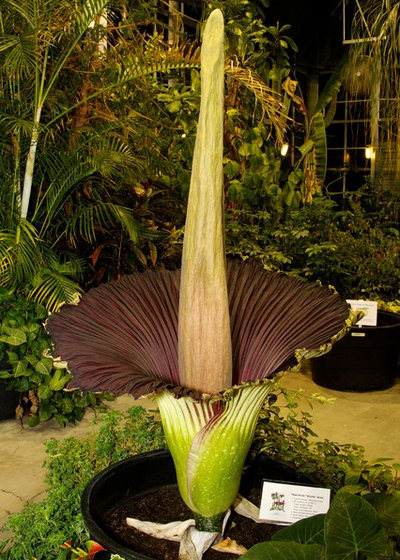
Woody — yes, that's this particular specimen's moniker; it's named after Ohio State University's beloved football coach, Woody Hayes — is a 12-year-old Titan Arum that bloomed last week. Once a seed the size of an almond, Woody is now a 49-pound tuber that's 12 feet tall when in leaf stage. Woody has had one other bloom during its life. The most recent bloom, pictured here, reached higher than 6 feet.
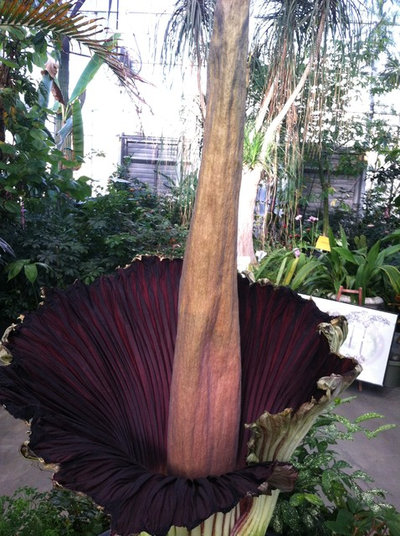
Most visitors will smell the flower long before they see it. The bloom often opens at night and gives off a strong scent for about 12 hours after. Most blooms tend to start wilting after 48 hours.
For Woody's most recent bloom, nearly 1,500 people came to the greenhouse to experience the foul odor. "Someone compared the smell to the liquid slop in the bottom of the Dumpster," says Leonard. "Another person told me they thought it smelled like a mouse that had been regurgitated by a snake after a few days."
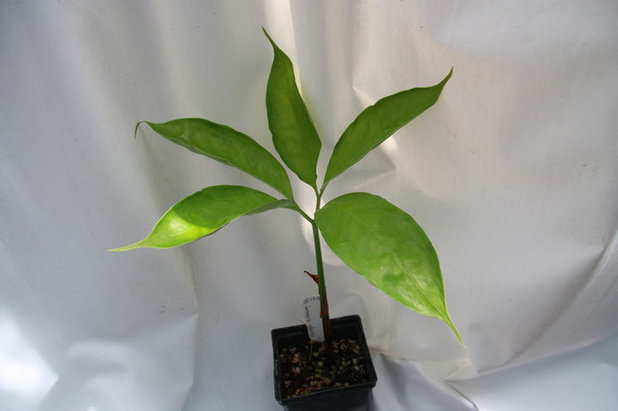
Although corpse flower blooms are rare, they've become much more common due to the germination of seeds by private collectors and institutions. The University of California Botanical Garden at Berkeley, for example, now sells seedlings for $50 to $100.
The seedlings (one is pictured here) do little to indicate what's ahead. The corpse flower goes through various dormancy and leaf cycles throughout its lifetime, wilting down to its root each time. After each period of dormancy and regeneration, the leaf and underground potato-like tuber grow considerably. Occasionally (and rarely) the plant will go through a stunning bloom cycle.
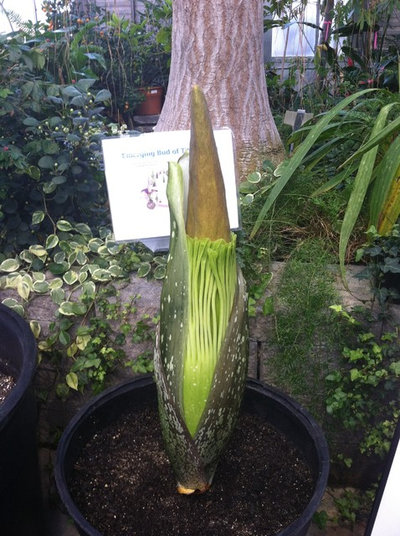
Here, Maudine — Ohio State's next slated Titan Arum bloom — displays the plant's emerging bud stage. Although Titan Arum is often referred to as the largest flower in the world, it's actually a group of flowers, called an inflorescence.
The stalk in the middle of the flower, called the spadix, has thousands of male and female flowers at its base. When the plant first opens, the female flowers open. After 12 hours they die, and the male flowers open and produce pollen. This process helps prevent self-pollination.
Note:
Maudine is named after Ohio State's 1926 homecoming queen — who was a cow.
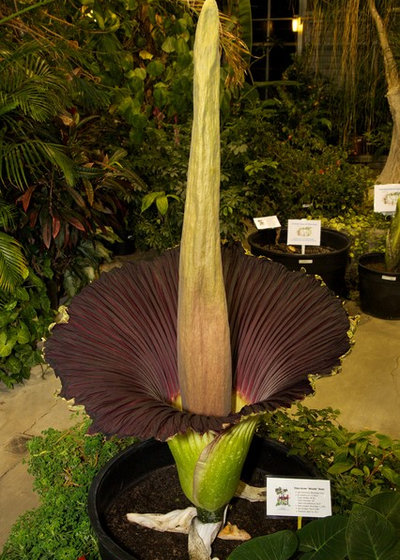
The spadix part of the plant is what produces the oh-so-distinct scent. In fact, the plant itself actually heats up — usually to around 98 degrees Fahrenheit — to help dissipate the odor. Combined with the bloom's unusual color ("It looks a lot like rotten liver," says Paul Licht, director of the University of California Botanical Garden at Berkeley. "It's very flesh-like."), the corpse flower truly mimics its namesake.
But why?
According to Licht, wild corpse flower plants are found only in Sumatra, an island in western Indonesia. Not only do they bloom rarely, but they have to be at least 10 years old before they do. Sumatra's tropical climate doesn't really have seasons, so the flower can bloom at any time of year. The likelihood of it being near another blooming corpse flower is slim, so the plant uses smell and color to attract carrion insects to pollinate it.
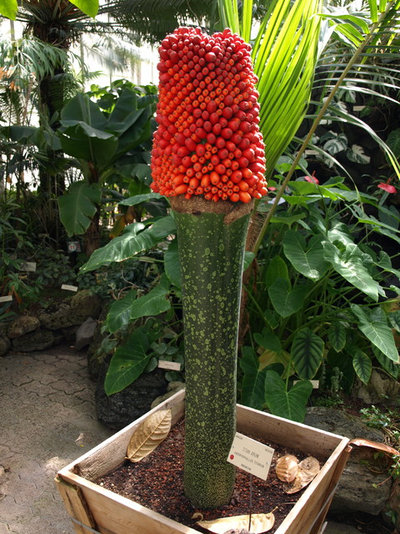
After it blooms the flower quickly collapses and rots. If it's been fertilized, brilliant red fruits — pictured here — start to grow at the top of the stalk. Eventually the plant goes back into dormancy, growing back after several months with an even bigger leaf or flower structure.

"Ninety-nine percent of the time, the flower isn't blooming," says Licht. "It's actually a beautiful, leafy plant." After each dormancy, a single leaf emerges from the ground. At first it's impossible to tell if it'll go into a bloom or leaf state. If it's the latter, the single leaf grows into a long stalk that branches out into leaflets — shown here. The plant itself grows very quickly, up to 3 inches a day in some cases.
Despite the crazy life cycle, the smell is still the most memorable thing about this curious plant. "We did have a visit from a person who works at the morgue, and she confirmed that corpse flower was an apt moniker," says Leonard.
Ready to sniff the corpse flower yourself? If you hurry you can take a whiff at the Ohio State University Biological Sciences Greenhouse. Maudine will bloom for two days starting around May 24, 2013.
Take a poll! Tell us what stage of the corpse flower you like best.





